Road signs in South Korea
Road signs in South Korea are regulated by the Korean Road Traffic Authority (Korean: 도로교통안전공단).
Signs indicating dangers are triangular with a red border, yellow background and black pictograms, similar to Road signs in Greece. Mandatory instructions are white on a blue background, prohibitions are black on a white background with a red border, and supplementary information signs are rectangular with black text on a white background. Like other countries, the signs use pictograms to display their meaning. Any text included in signs will normally be in Korean and English. Signs are normally placed 1 to 2.1 meters high.
South Korean road signs depict people with realistic (as opposed to stylized) silhouettes.
South Korea signed the Vienna Convention on Road Signs and Signals but have yet to ratify the Convention.
Warning signs
Warning signs are triangular with yellow backgrounds, red borders and black pictograms.
 Crossroad
Crossroad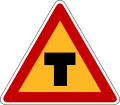 T-shaped intersection
T-shaped intersection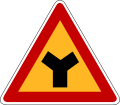 Y-shaped intersection
Y-shaped intersection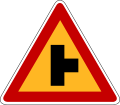 ㅏ-shaped intersection
ㅏ-shaped intersection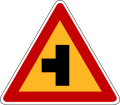 ㅓ-shaped intersection
ㅓ-shaped intersection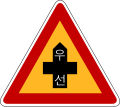 Through street
Through street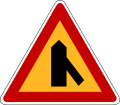 Traffic merge from right
Traffic merge from right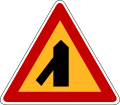 Traffic merge from left
Traffic merge from left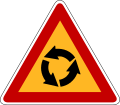 Traffic circle / Roundabout
Traffic circle / Roundabout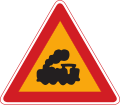 Railway crossing
Railway crossing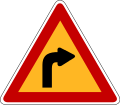 Right curve
Right curve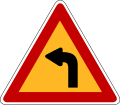 Left curve
Left curve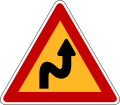 Double bend, the first to the right
Double bend, the first to the right Double bend, the first to the left
Double bend, the first to the left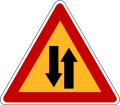 Two-way traffic
Two-way traffic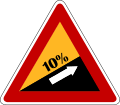 Ascending hill
Ascending hill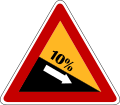 Descending hill
Descending hill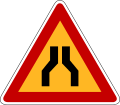 Narrow carriageway
Narrow carriageway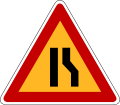 Right lane decrease / End of right crawler lane
Right lane decrease / End of right crawler lane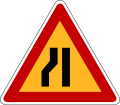 Left lane decrease / End of left crawler lane
Left lane decrease / End of left crawler lane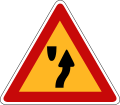 Keep right
Keep right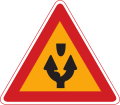 Pass left or right
Pass left or right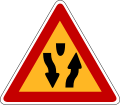 Start of dual carriageway
Start of dual carriageway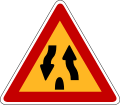 End of dual carriageway
End of dual carriageway Traffic lights
Traffic lights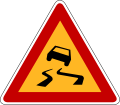 Slippery road
Slippery road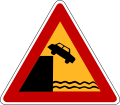 Riverside road (quayside or river bank)
Riverside road (quayside or river bank)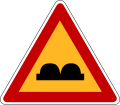 Bumpy road
Bumpy road Speed humps
Speed humps Falling rocks
Falling rocks.svg.png) Loose chippings (retired on September 28, 2007)
Loose chippings (retired on September 28, 2007) Crosswalk (pedestrian crossing)
Crosswalk (pedestrian crossing)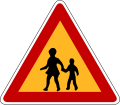 Children crossing ahead
Children crossing ahead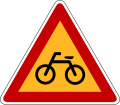 Bicycles
Bicycles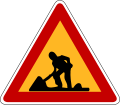 Roadworks
Roadworks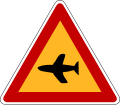 Airplanes
Airplanes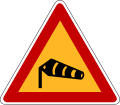 Crosswind
Crosswind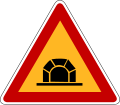 Tunnel
Tunnel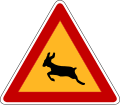 Wild animals crossing
Wild animals crossing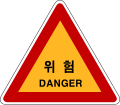 Danger
Danger
Prohibition signs
Prohibition signs are round with white backgrounds, red borders and black pictograms.
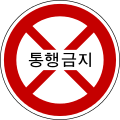 Road closed
Road closed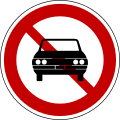 No motor vehicles
No motor vehicles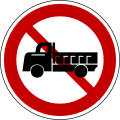 No trucks
No trucks No buses
No buses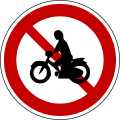 No motorcycles and mopeds
No motorcycles and mopeds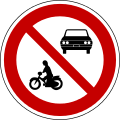 No motor vehicles, motorcycles and mopeds
No motor vehicles, motorcycles and mopeds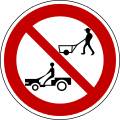 No rotary tillers, tractors or handcarts
No rotary tillers, tractors or handcarts.svg.png) No tractors or rotary tillers (retired on September 28, 2007)
No tractors or rotary tillers (retired on September 28, 2007).svg.png) No oxcarts or horse-drawn carts (retired on September 28, 2007)
No oxcarts or horse-drawn carts (retired on September 28, 2007).svg.png) No handcarts (retired on September 28, 2007)
No handcarts (retired on September 28, 2007)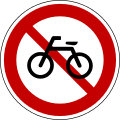 No bicycles
No bicycles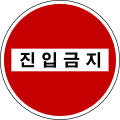 No entry
No entry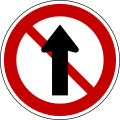 No straight ahead
No straight ahead No right turn
No right turn No left turn
No left turn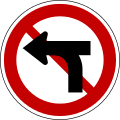 No crossing traffic (retired on September 28, 2007)
No crossing traffic (retired on September 28, 2007)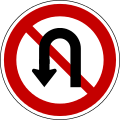 No U-turn
No U-turn No overtaking
No overtaking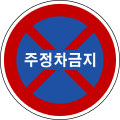 No stopping or parking
No stopping or parking.svg.png) No stopping or parking (retired)
No stopping or parking (retired)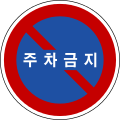 No parking
No parking.svg.png) No parking (retired)
No parking (retired)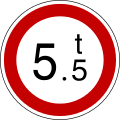 Maximum weight limit
Maximum weight limit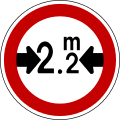 Maximum width limit
Maximum width limit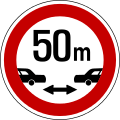 Minimum safe distance between vehicles
Minimum safe distance between vehicles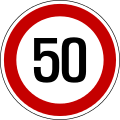 Maximum speed limit
Maximum speed limit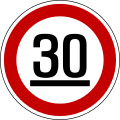 Minimum speed limit
Minimum speed limit.svg.png) No horn (retired)
No horn (retired)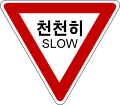 Slow
Slow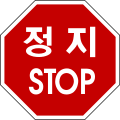 Stop
Stop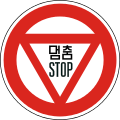 Stop (retired)
Stop (retired)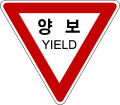 Yield
Yield.svg.png) No pedestrian crossing (retired on September 28, 2007)
No pedestrian crossing (retired on September 28, 2007).svg.png) No pedestrians (retired on September 28, 2007)
No pedestrians (retired on September 28, 2007)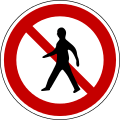 No pedestrians
No pedestrians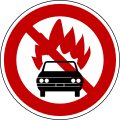 No vehicles carrying dangerous substances / explosives
No vehicles carrying dangerous substances / explosives
Mandatory instruction signs
Mandatory instruction signs are round with blue backgrounds and white pictograms.
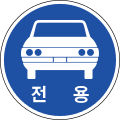 Motor Vehicles Only
Motor Vehicles Only.svg.png) Motor Vehicles Only (retired)
Motor Vehicles Only (retired)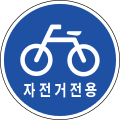 Bicycles Only
Bicycles Only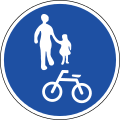 Bicycles and Pedestrians Only
Bicycles and Pedestrians Only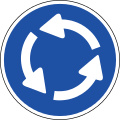 Traffic circle / Roundabout
Traffic circle / Roundabout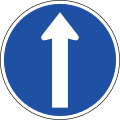 Straight
Straight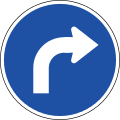 Right Turn
Right Turn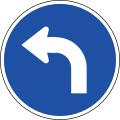 Left Turn
Left Turn Straight and Right Turn
Straight and Right Turn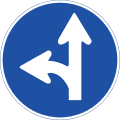 Straight and Left Turn
Straight and Left Turn Left Turn and Right Turn
Left Turn and Right Turn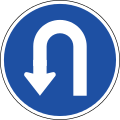 U-Turn
U-Turn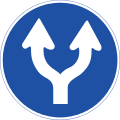 Pass Left or Right
Pass Left or Right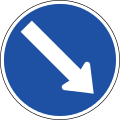 Pass Right
Pass Right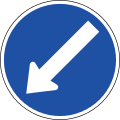 Pass Left
Pass Left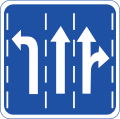 Follow Directions
Follow Directions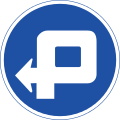 Diversion / Detour
Diversion / Detour.svg.png) Honk horn (retired)
Honk horn (retired).svg.png) Mandatory use of snow tires or chains (retired)
Mandatory use of snow tires or chains (retired).svg.png) Safety zone (retired)
Safety zone (retired)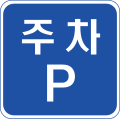 Parking Lot
Parking Lot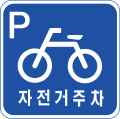 Bicycle Parking Lot
Bicycle Parking Lot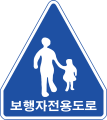 Pedestrians Only
Pedestrians Only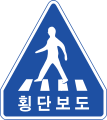 Crosswalk (Pedestrian crossing)
Crosswalk (Pedestrian crossing) Senior citizens crossing (In the Silver zone)
Senior citizens crossing (In the Silver zone) Children crossing (In the School zone)
Children crossing (In the School zone)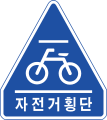 Bicycles Crossing
Bicycles Crossing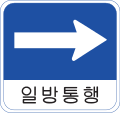 One Way
One Way One Way
One Way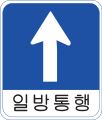 One Way
One Way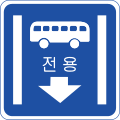 Bus only Lane
Bus only Lane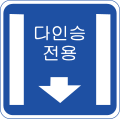 HOV Lane
HOV Lane
Supplementary signs
Supplementary signs are rectangular with white backgrounds and black text. Most of signs are only written in Korean.
.svg.png) District (Whole Downtown)
District (Whole Downtown).svg.png) Date (Except for Sunday and Holidays)
Date (Except for Sunday and Holidays).svg.png) Time
Time.svg.png) Time (You can park here within 1 hour)
Time (You can park here within 1 hour).svg.png) Traffic light status (When the red light turned on)
Traffic light status (When the red light turned on).svg.png) Front through road
Front through road.svg.png) Safe speed (30 km/h)
Safe speed (30 km/h).svg.png) Weather condition (foggy area)
Weather condition (foggy area).svg.png) Road condition (when snow or rain falls)
Road condition (when snow or rain falls).svg.png) Traffic control (get in lane)
Traffic control (get in lane).svg.png) Traffic regulation (do not cross)
Traffic regulation (do not cross).svg.png) Vehicles limitation (only for sedans)
Vehicles limitation (only for sedans).svg.png) Sign explanation (tunnel length is 258m)
Sign explanation (tunnel length is 258m)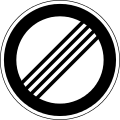 End (retired)
End (retired).svg.png) End (retired)
End (retired).svg.png) End
End.svg.png) Tow-away zone
Tow-away zone
Direction and distance signs
Direction and distance signs are rectangular with dark green backgrounds and white text. In urban areas, direction signs have dark blue backgrounds. The signs are normally written in Korean and English. In March 2010, Korea Expressway Corporation introduced a new type of direction sign for expressways.[1] Currently, Korea Expressway Corporation changes old direction signs to new ones on their expressways. This new type of direction sign is exit guide based sign and its typeface has changed from Sandol Doropyojipanche (Sandol traffic sign typeface, which can be seen on the distance sign and direction sign below) to Hangilche (Hangil typeface).
 Distance sign
Distance sign Direction sign (with name of junction)
Direction sign (with name of junction) New expressway direction sign (introduced in early 2010)
New expressway direction sign (introduced in early 2010)
Other signs
 Asian Highway route shield
Asian Highway route shield
| Wikimedia Commons has media related to Road signs in South Korea. |